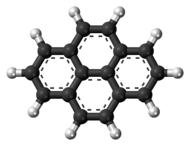Pyrene
 | |
 | |
| Names | |
|---|---|
| Preferred IUPAC name
Pyrene | |
| Other names
Benzo[def]phenanthrene | |
| Identifiers | |
| 129-00-0 | |
| 3D model (Jmol) | Interactive image |
| 1307225 | |
| ChEBI | CHEBI:39106 |
| ChEMBL | ChEMBL279564 |
| ChemSpider | 29153 |
| ECHA InfoCard | 100.004.481 |
| 84203 | |
| KEGG | C14335 |
| PubChem | 31423 |
| RTECS number | UR2450000 |
| |
| |
| Properties | |
| C16H10 | |
| Molar mass | 202.25 g/mol |
| Appearance | colorless solid
(yellow impurities are often found at trace levels in many samples). |
| Density | 1.271 g/mL |
| Melting point | 145 to 148 °C (293 to 298 °F; 418 to 421 K) |
| Boiling point | 404 °C (759 °F; 677 K) |
| 0.135 mg/L | |
| Hazards | |
| Main hazards | irritant |
| R-phrases | 36/37/38-45-53 |
| S-phrases | 24/25-26-36 |
| NFPA 704 | |
| Flash point | non-flammable |
| Related compounds | |
| Related PAHs |
benzopyrene |
| Except where otherwise noted, data are given for materials in their standard state (at 25 °C [77 °F], 100 kPa). | |
| | |
| Infobox references | |
Pyrene is a polycyclic aromatic hydrocarbon (PAH) consisting of four fused benzene rings, resulting in a flat aromatic system. The chemical formula is C
16H
10. This colorless solid is the smallest peri-fused PAH (one where the rings are fused through more than one face). Pyrene forms during incomplete combustion of organic compounds.
Occurrence and reactivity
Pyrene was first isolated from coal tar, where it occurs up to 2% by weight. As a peri-fused PAH, pyrene is much more resonance-stabilized than its five-member-ring containing isomer fluoranthene. Therefore, it is produced in a wide range of combustion conditions. For example, automobiles produce about 1 μg/km.[1] More than 20% of the carbon in the universe may be associated with PAHs, including pyrene.[2]
Oxidation with chromate affords perinaphthenone and then naphthalene-1,4,5,8-tetracarboxylic acid. It undergoes a series of hydrogenation reactions, and it is susceptible to halogenation, Diels-Alder additions, and nitration, all with varying degrees of selectivity.[1] Bromination occurs at one of the 3-positions.[3]
Applications
Pyrene and its derivatives are used commercially to make dyes and dye precursors, for example pyranine and naphthalene-1,4,5,8-tetracarboxylic acid. Its derivatives are also valuable molecular probes via fluorescence spectroscopy, having a high quantum yield and lifetime (0.65 and 410 nanoseconds, respectively, in ethanol at 293 K). Its fluorescence emission spectrum is very sensitive to solvent polarity, so pyrene has been used as a probe to determine solvent environments. This is due to its excited state having a different, non-planar structure than the ground state. Certain emission bands are unaffected, but others vary in intensity due to the strength of interaction with a solvent.
Safety

Although it is not as problematic as benzopyrene, animal studies have shown pyrene is toxic to the kidneys and the liver.
Experiments in pig show that urinary 1-hydroxypyrene is a metabolite of pyrene, when given orally.[5]
See also
References
- 1 2 Senkan, Selim and Castaldi, Marco (2003) "Combustion" in Ullmann's Encyclopedia of Industrial Chemistry, Wiley-VCH, Weinheim.
- ↑ Hoover, Rachel (February 21, 2014). "Need to Track Organic Nano-Particles Across the Universe? NASA's Got an App for That". NASA. Retrieved February 22, 2014.
- ↑ Gumprecht, W. H. (1968) "3-Bromopyrene" Org. Synth., vol. 48, p. 30. doi:10.15227/orgsyn.048.0030
- ↑ Pham, Tuan Anh; Song, Fei; Nguyen, Manh-Thuong; Stöhr, Meike (2014). "Self-assembly of pyrene derivatives on Au(111): Substituent effects on intermolecular interactions". Chem. Commun. 50 (91): 14089. doi:10.1039/C4CC02753A.
- ↑ Keimig, S. D.; Kirby, K. W.; Morgan, D. P.; Keiser, J. E.; Hubert, T. D. (1983). "Identification of 1-hydroxypyrene as a major metabolite of pyrene in pig urine". Xenobiotica. 13 (7): 415. doi:10.3109/00498258309052279. PMID 6659544.
Further reading
- Birks, J. B. (1969). Photophysics of Aromatic Molecules. London: Wiley.
- Valeur, B. (2002). Molecular Fluorescence: Principles and Applications. New York: Wiley-VCH.
- Birks, J.B. (1975). Eximers. london: Reports on Progress in Physics.
- Fetzer, J. C. (2000). The Chemistry and Analysis of the Large Polycyclic Aromatic Hydrocarbons. New York: Wiley.



